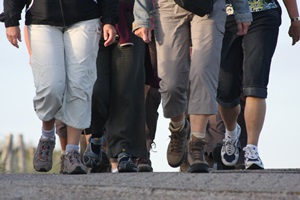The Key to More Independence in Your Senior Years? Start Walking Now!
Will you be able to maintain your independence as you reach your golden years? Recent research indicates that the answer to that question may actually depend on how you answer another question: “Can you comfortably walk a quarter of a mile?”
If your answer is “No” you’re not alone. 24 million older Americans have trouble walking that far, and 13 million more can’t walk a quarter-mile at all. According to a new article published in the Journal of the American Medical Association (JAMA), this puts these people at a huge risk of becoming disabled and losing their independence.
In recent years, inactivity (leading a sedentary lifestyle) has been found to be a major risk factor for serious conditions like cancer, heart disease, diabetes, and stroke. In fact, the U.S. Centers for Disease Control and Prevention released a report suggesting that inactivity is now killing more people every year than smoking. Inactivity is an even larger problem for older people because without exercise they begin to lose muscle mass and their sense of balance deteriorates more quickly. This puts them at increased risk of injury from falls—the leading injury-related cause of death among seniors.
In the JAMA study, researchers in eight states worked with people in their 70s and 80s who reported that they had developed a sedentary, inactive lifestyle. At the beginning of the study, these people were (on average) active less than 20 minutes a week. As a result, they were considered at high risk of becoming disabled due to lack of strength in their legs.
The study participants met twice a week to perform simple exercises to strengthen their legs and walk in a group, and were also asked to walk more at home. The goal for all participants was to engage in 150 minutes of activity each week and to become fit enough to walk a quarter of a mile without any outside assistance (other than using a cane). Interestingly, the quarter-mile distance wasn’t chosen by researchers at random. Rather, this distance is significant because city planners use it as a “livability” reference point. A city is considered “livable” if all the goods and services you need for day-to-day life are attainable within a quarter-mile of the closest public transportation stop. This means that if you can’t easily walk a quarter-mile, you may have effectively lost your ability to lead an independent life.
At the end of the 2.6-year JAMA study, all participants were able to comfortably walk that distance, and all felt that their general health and mobility had improved. Even more important, a significantly smaller percentage of them had become temporarily or permanently disabled, compared to people of the same age who had maintained a sedentary lifestyle.
The clear message from this study is that you can (quite literally) take steps TODAY to improve your own odds of staying healthy, happy, and independent in the future. Developing a new walking habit is a great way to ensure that you’re getting enough exercise while maintaining your mobility. Plus, it doesn’t cost anything and it doesn’t require any equipment more elaborate than a comfortable pair of shoes. And—maybe best of all—walking is an activity that you can do either socially as part of a group or on your own. Many local communities around the country even have seniors clubs that organize walks on a regular basis.
The key to aging well is to stay healthy, stay active and stay engaged. Building good habits now can make all the difference years from now. If you’d like to learn more about how you can keep your musculoskeletal system in good working order, just call or visit our office at Oblander Chiropractic today! Our phone number is 406-652-3553.
